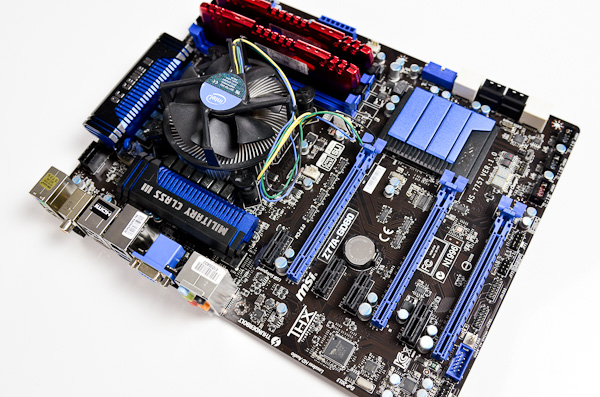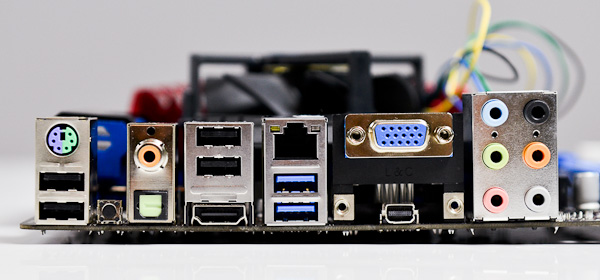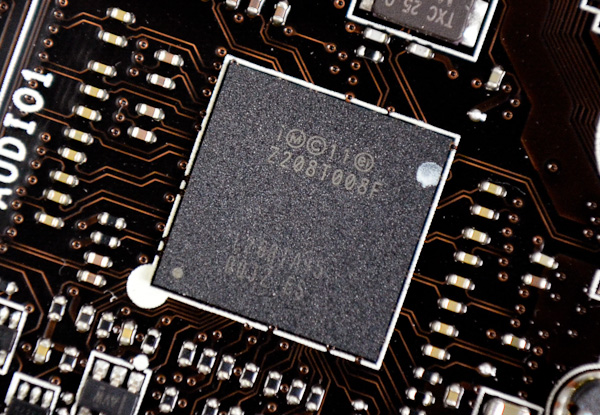A First Look at Thunderbolt on Windows with MSI's Z77A-GD80
by Anand Lal Shimpi on May 11, 2012 1:32 PM EST- Posted in
- Motherboards
- CPUs
- Intel
- MSI
- Thunderbolt
Update: Intel has informed us that we will see updated drivers for Windows certified Thunderbolt devices that will enable hot plugging under Windows as well as address some of the behavior we've seen. Intel further informed us that MSI's board has not yet made it through the certification process and a lot of these teething issues will hopefully be addressed by then.
I finally made the transition to a notebook as my desktop last year, a move many had made years prior. Quad-core mobile Sandy Bridge and good SSDs made the move simple for me, but Thunderbolt eventually made it near perfect. With only two drive bays in my notebook (I ditched my optical drive so I could have another SSD, something Brian Klug did back in 2010), there wasn't any room for good, high-performance, mass storage. Thunderbolt solved this problem for me.
Co-developed by Apple and Intel, Thunderbolt is a tunnel that carries both PCIe and DisplayPort traffic to the tune of 20Gbps per channel (10Gbps up and down). In the past, whenever you wanted to add a PCIe device (LAN, audio, high-speed storage, etc...) you needed to physically install that device in your system either via an ExpressCard slot on a notebook or via a PCIe slot on your desktop. Thunderbolt acts as a decoupler for PCIe devices, allowing you to put controllers that would traditionally lie inside your system outside of it, or even inside another device like a display. That's where the DisplayPort support comes in.
Apple's Thunderbolt Display is the perfect example of what Thunderbolt can be used to do. Take a DisplayPort panel, integrate Gigabit Ethernet, Firewire 800, audio and USB controllers and you've got Apple's Thunderbolt Display. In theory, you could connect a system that had none of these things, and the functionality would be provided exclusively by the display. Decoupling hardware like this allows OEMs to build thinner and/or smaller form factor machines (think Ultrabooks/MacBook Air), while allowing for full functionality when connected to a display. By carrying DisplayPort over the same cable, you can have a single cable that both extends functionality and connects your small form factor machine to a larger monitor. Thunderbolt enables the modern day dock for notebooks.
For all of last year, Thunderbolt was an Apple exclusive. This year, starting with the launch of Ivy Bridge, Thunderbolt is coming to PCs. We'll see it on notebooks as well as some desktop motherboards. Today we have the very first desktop motherboard with Thunderbolt support: MSI's Z77A-GD80.
Don't expect ubiquitous deployment of Thunderbolt, especially not on desktops, as the Thunderbolt controller and associated components add cost where margins are already very thin. Instead you can expect higher end motherboards to integrate it, or offer an add-in card of sorts which is the route ASUS is taking. I'd expect Ultrabooks to make better use of Thunderbolt naturally, but we will see it on desktops this year.
The Z77A-GD80 is a very full featured ATX Z77 motherboard. You get three physical PCIe x16 slots, although they are only supported in the following configurations:
| MSI Z77A-GD80 PCIe x16 Supported Configurations | ||||
| Ivy Bridge | Sandy Bridge | |||
| PCIe x16/0/0 | 1 x16 | 1 x16 | ||
| PCIe x8/8/0 | 2 x8 | 2 x8 | ||
| PCIe x8/4/4 | 1 x8 + 2 x4 | Not Supported | ||
Both CrossFire and SLI are supported.
You'll find a standard eight SATA ports on the motherboard (4 x 6Gbps, 4 x 3Gbps, 6 driven by Intel's controller). USB 3.0 comes native thanks to Intel's Z77 chipset, with two ports on the rear IO panel as well as a header and a supplied bracket for two more ports. Intel LAN comes standard as well. Audio is driven by a Realtek ALC898 controller, while VIA's VT6315N powers the on-board Firewire header.
The Star of the Show: Thunderbolt
The big news is of course the Thunderbolt port on the IO panel. Counting it, there are a total of three display outputs on the GD80, the other two are VGA and HDMI.
I believe the Thunderbolt controller on the GD80 is this little chip on the board, just behind the analog audio outputs on the IO panel. It also looks like the controller branches off of the Z77 PCH's PCIe 2.0 lanes. Although there are four PCIe x1 slots on the board, you can only use two at a time - likely because of the way the Thunderbolt controller connects to the system as it uses 4 of the 8 available PCIe 2.0 lanes. The remaining lanes aren't enough to support the on-board LAN, Firewire, audio and SATA controllers in addition to the extra PCIe slots and Thunderbolt. As a result there are limitations on what you can use in parallel (e.g. you can't use Firewire and SATA ports 7/8) in order to deal with the PCIe overprovisioning.
The markings on the Thunderbolt controller aren't familiar, so it could very well be that we're looking at Cactus Ridge - Intel's 2012 Thunderbolt controller we first heard about last year. Cactus Ridge doesn't change performance, it just helps reduce cost by integrating more functionality into the controller itself.
The beauty of Thunderbolt is it's near invisible to the OS. You don't need to install any drivers to take advantage of it, just plug your devices in and as long as your devices have driver support they'll just appear. The OS has no idea that your SATA, Ethernet or RAID controllers are sitting a few feet outside of your box, they all appear as normal PCIe devices.
As we found in our initial review of Thunderbolt on the MacBook Pro, Windows does not allow for the hot plugging of Thunderbolt devices. You can remove a Thunderbolt device once in Windows, but you cannot add a new one. Anything you want access to in Windows has to be plugged in at boot. OS X allows more flexibility in this regard as you can add/remove Thunderbolt storage and other devices while the OS is running, but even then it's not always well behaved. It's not all that uncommon to need a reboot after plugging in a chain of Thunderbolt devices under OS X, although admittedly Apple has been improving compatibility and behavior over time.
Update: Intel has informed us that we will see updated drivers for Windows certified Thunderbolt devices that will enable hot plugging under Windows. Intel further informed us that MSI's board has not yet made it through the certification process and a lot of these teething issues will hopefully be addressed by then.






















98 Comments
View All Comments
AnTech - Saturday, May 12, 2012 - link
It should be possible to power on a computer from a Thunderbolt port, as was previously possible with Macs using a device like the i-Cue for USBhttp://www.lindy.co.uk/usb-boot-dongle-i-cue-for-m...
or the former ADB Apple keyboards that also allowed powering on the Mac from them. That is really convenient when the computer is away and difficult to reach, below the table, etc.
rikm - Saturday, May 12, 2012 - link
First page says: Co-developed by Apple and Intel, Thunderbolt is a tunnel that carries both PCIe and DisplayPort traffic to the tune of 20Gbps per channel (10Gbps up and down).Page 3 says: Total available bandwidth for a single-port Thunderbolt device is 20Gbps bi-directional (40Gbps total), so there's still additional headroom available.
Which is it?
KitsuneKnight - Saturday, May 12, 2012 - link
It's 10Gbps up or down per channel. So 20Gbps per channel.There's 2 channels, so there's a total, aggregate bandwidth of 40Gbps in both directions.
So it's both.
buzznut - Saturday, May 12, 2012 - link
This is a very vanilla looking board for around $200. And the PCI-express lanes are pathetic. They choose to implement Thunderbolt on a motherboard with how many lanes??I like msi so I really don't understand this. And for some reason, Intel motherboards in general don't provide enough PCIx lanes. As features are added, it seems like they limit the lanes even more. What gives?
In my opinion, someone would have to be pretty desperate to have Thunderbolt in their system if this board is representative of most implementations. Sure, its a new technology but this is indicative of a larger problem-Intel had the same problem with their implementation of USB 3.0; not enough PCI express lanes. A person would be foolish to use this board with crossfire or sli.
ggathagan - Saturday, May 12, 2012 - link
Why desperate ?I think many are not understanding ThunderBolt.
It's not a device in-and-of-itself, it's a flexible bus mechanism that's fairly protocol-independent.
You're viewing it as something that consumes x4 PCIe lanes, eliminating their use by another device.
That's not accurate.
In the case of this board, it allows you to use the 4x bandwidth for USB, firewire, SATA, DP, gigabit ethernet or any combination thereof.
If a motherboard vendor chose to do so, they could link it to a PCIe 3 x16 lane and still not utilize TB's full bandwidth.
Given the tests that show little or no difference in PCIe 2 x8 vs x16 performance, that opens a LOT of possibilities.
repoman27 - Sunday, May 13, 2012 - link
Ivy Bridge LGA 1155 CPU's provide 16 PCIe 3.0 lanes for dGPU use, which is pretty much twice the bandwidth that came with Sandy Bridge and plenty for most setups.The PCH continues to offer 8 PCIe 2.0 lanes for additional features, which is about all that is reasonable given the 20 Gbps limit of the DMI 2.0 connection to the CPU. The more features a motherboard manufacturer adds, the more of these lanes they consume, and the fewer that are left available to the end user as open PCIe slots. By my count, MSI have used 6 of the 8 lanes branching off of the PCH by adding Thunderbolt, FireWire and an additional SATA 6 Gbps controller.
If you really think 16 GB/s of bandwidth isn't enough for your particular CrossFire or SLI setup, you can always go with an LGA 2011 solution which would give you 40. The bottom line is that if you want more PCIe lanes, you need a bigger socket with a lot more pins to provide those connections, and that ain't cheap.
richard451 - Saturday, May 12, 2012 - link
It's odd that the article states multiple times that Thunderbolt does not need any drivers for the OS to take advantage of it, yet the update from Intel states once Windows gets updated Thunderbolt drivers things will improve.ggathagan - Saturday, May 12, 2012 - link
The comments about drivers from Intel revolve around extending hot-swap capability to TB-connected devices.Much like hot-swap AHCI is supported in Windows 7 while not in XP, the basic functionality for the connectivity in W7 is due to TB connections being seen as a PCIe device or a DP device in W7, while the hot-swap functionality has to be achieved through drivers.
I suspect Windows 8 might have said capability built in.
I doubt MS is interested in doing the same for W7, since they want us all to move forward on their 'enlightened' Metro path.
repoman27 - Sunday, May 13, 2012 - link
To clarify, the Thunderbolt controller does not require any drivers, but the devices you connect via Thunderbolt may.Thunderbolt devices tend to include PCIe hardware for which Windows drivers already exist, but the drivers were not designed with hot-plugging in mind. Once the drivers are tweaked to support hot-plugging, the devices won't require a restart in order to be recognized by the system, and will become eligible for Thunderbolt certification for Windows.
It's the drivers for the PCIe connected hardware in the Thunderbolt devices that need updating in order to work properly in the new Thunderbolt context.
SimoxTav - Saturday, May 12, 2012 - link
May I suggest to take a look at the performance videos of the eGPU solution listed on the topic?http://forum.notebookreview.com/8267588-post1.html
Check the "1.2Opt-Int" videos (scroll down) that means "x1 PCI 2.0 + Optimus Compression on internal screen". The results are IMHO quite enjoyable with a GTX560. With Thunderbolt can only be better (and easier to be implemented). Currently the performance are about 75-80% of the x16 counterpart (obviously depending on the specific game).